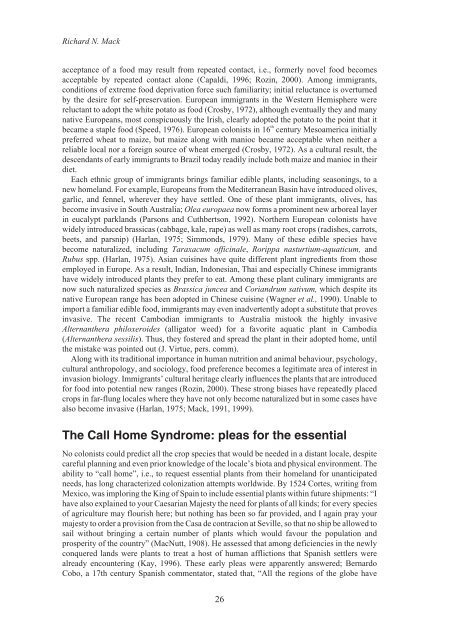Alien Species.vp - IUCN
Alien Species.vp - IUCN
Alien Species.vp - IUCN
You also want an ePaper? Increase the reach of your titles
YUMPU automatically turns print PDFs into web optimized ePapers that Google loves.
Richard N. Mack<br />
acceptance of a food may result from repeated contact, i.e., formerly novel food becomes<br />
acceptable by repeated contact alone (Capaldi, 1996; Rozin, 2000). Among immigrants,<br />
conditions of extreme food deprivation force such familiarity; initial reluctance is overturned<br />
by the desire for self-preservation. European immigrants in the Western Hemisphere were<br />
reluctant to adopt the white potato as food (Crosby, 1972), although eventually they and many<br />
native Europeans, most conspicuously the Irish, clearly adopted the potato to the point that it<br />
became a staple food (Speed, 1976). European colonists in 16 th<br />
century Mesoamerica initially<br />
preferred wheat to maize, but maize along with manioc became acceptable when neither a<br />
reliable local nor a foreign source of wheat emerged (Crosby, 1972). As a cultural result, the<br />
descendants of early immigrants to Brazil today readily include both maize and manioc in their<br />
diet.<br />
Each ethnic group of immigrants brings familiar edible plants, including seasonings, to a<br />
new homeland. For example, Europeans from the Mediterranean Basin have introduced olives,<br />
garlic, and fennel, wherever they have settled. One of these plant immigrants, olives, has<br />
become invasive in South Australia; Olea europaea now forms a prominent new arboreal layer<br />
in eucalypt parklands (Parsons and Cuthbertson, 1992). Northern European colonists have<br />
widely introduced brassicas (cabbage, kale, rape) as well as many root crops (radishes, carrots,<br />
beets, and parsnip) (Harlan, 1975; Simmonds, 1979). Many of these edible species have<br />
become naturalized, including Taraxacum officinale, Rorippa nasturtium-aquaticum, and<br />
Rubus spp. (Harlan, 1975). Asian cuisines have quite different plant ingredients from those<br />
employed in Europe. As a result, Indian, Indonesian, Thai and especially Chinese immigrants<br />
have widely introduced plants they prefer to eat. Among these plant culinary immigrants are<br />
now such naturalized species as Brassica juncea and Coriandrum sativum, which despite its<br />
native European range has been adopted in Chinese cuisine (Wagner et al., 1990). Unable to<br />
import a familiar edible food, immigrants may even inadvertently adopt a substitute that proves<br />
invasive. The recent Cambodian immigrants to Australia mistook the highly invasive<br />
Alternanthera philoxeroides (alligator weed) for a favorite aquatic plant in Cambodia<br />
(Alternanthera sessilis). Thus, they fostered and spread the plant in their adopted home, until<br />
the mistake was pointed out (J. Virtue, pers. comm).<br />
Along with its traditional importance in human nutrition and animal behaviour, psychology,<br />
cultural anthropology, and sociology, food preference becomes a legitimate area of interest in<br />
invasion biology. Immigrants’ cultural heritage clearly influences the plants that are introduced<br />
for food into potential new ranges (Rozin, 2000). These strong biases have repeatedly placed<br />
crops in far-flung locales where they have not only become naturalized but in some cases have<br />
also become invasive (Harlan, 1975; Mack, 1991, 1999).<br />
The Call Home Syndrome: pleas for the essential<br />
No colonists could predict all the crop species that would be needed in a distant locale, despite<br />
careful planning and even prior knowledge of the locale’s biota and physical environment. The<br />
ability to “call home”, i.e., to request essential plants from their homeland for unanticipated<br />
needs, has long characterized colonization attempts worldwide. By 1524 Cortes, writing from<br />
Mexico, was imploring the King of Spain to include essential plants within future shipments: “I<br />
have also explained to your Caesarian Majesty the need for plants of all kinds; for every species<br />
of agriculture may flourish here; but nothing has been so far provided, and I again pray your<br />
majesty to order a provision from the Casa de contracion at Seville, so that no ship be allowed to<br />
sail without bringing a certain number of plants which would favour the population and<br />
prosperity of the country” (MacNutt, 1908). He assessed that among deficiencies in the newly<br />
conquered lands were plants to treat a host of human afflictions that Spanish settlers were<br />
already encountering (Kay, 1996). These early pleas were apparently answered; Bernardo<br />
Cobo, a 17th century Spanish commentator, stated that, “All the regions of the globe have<br />
26












